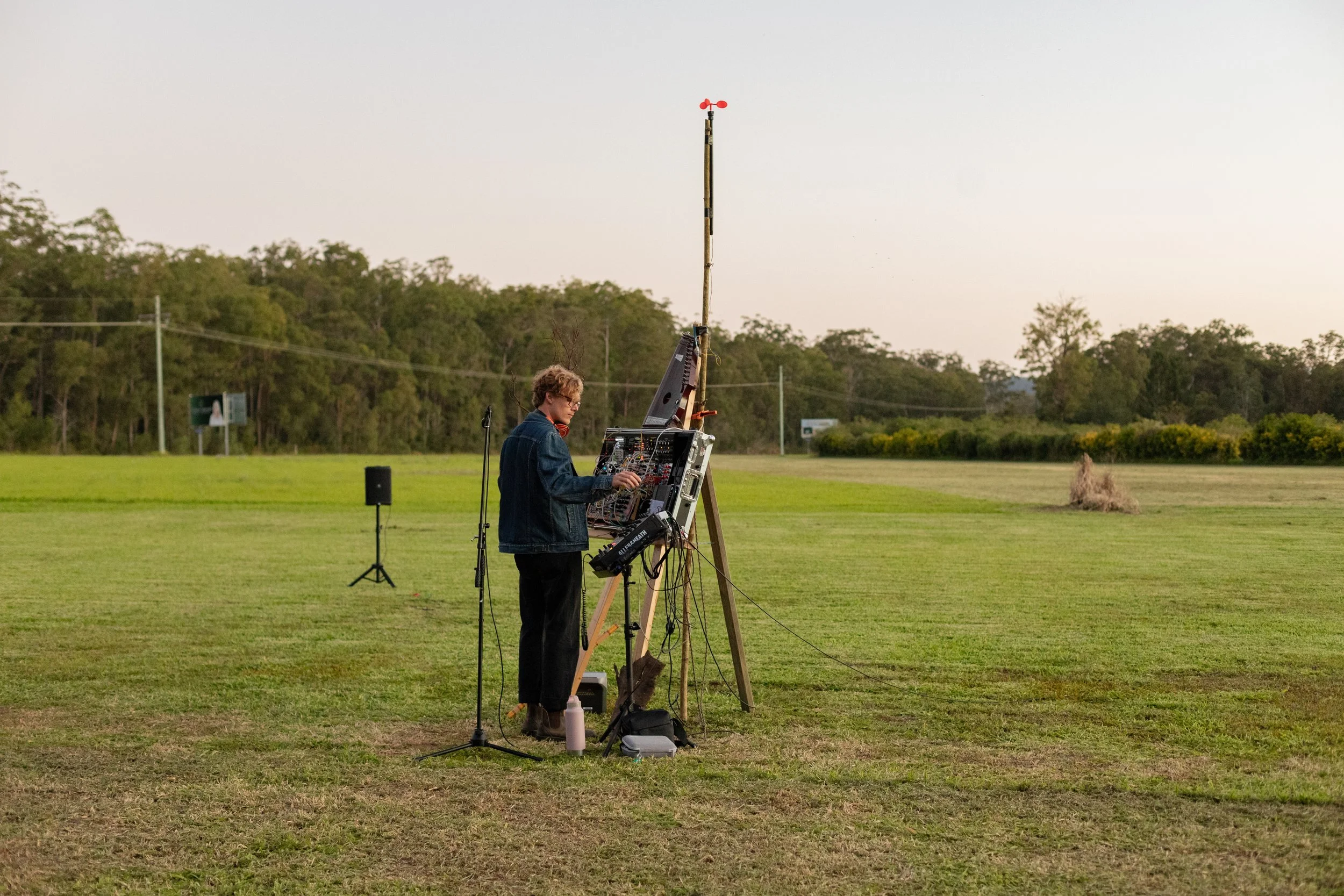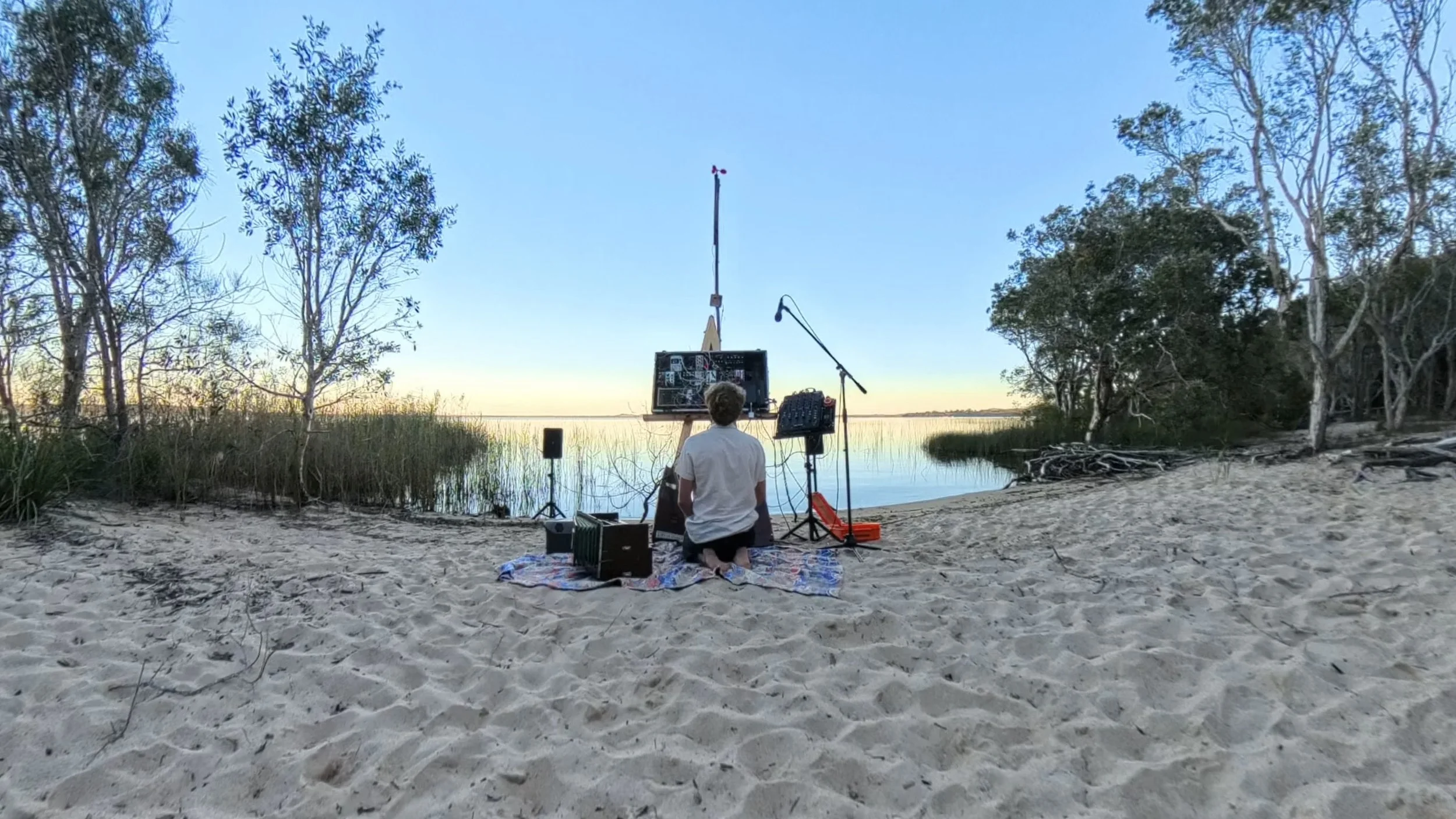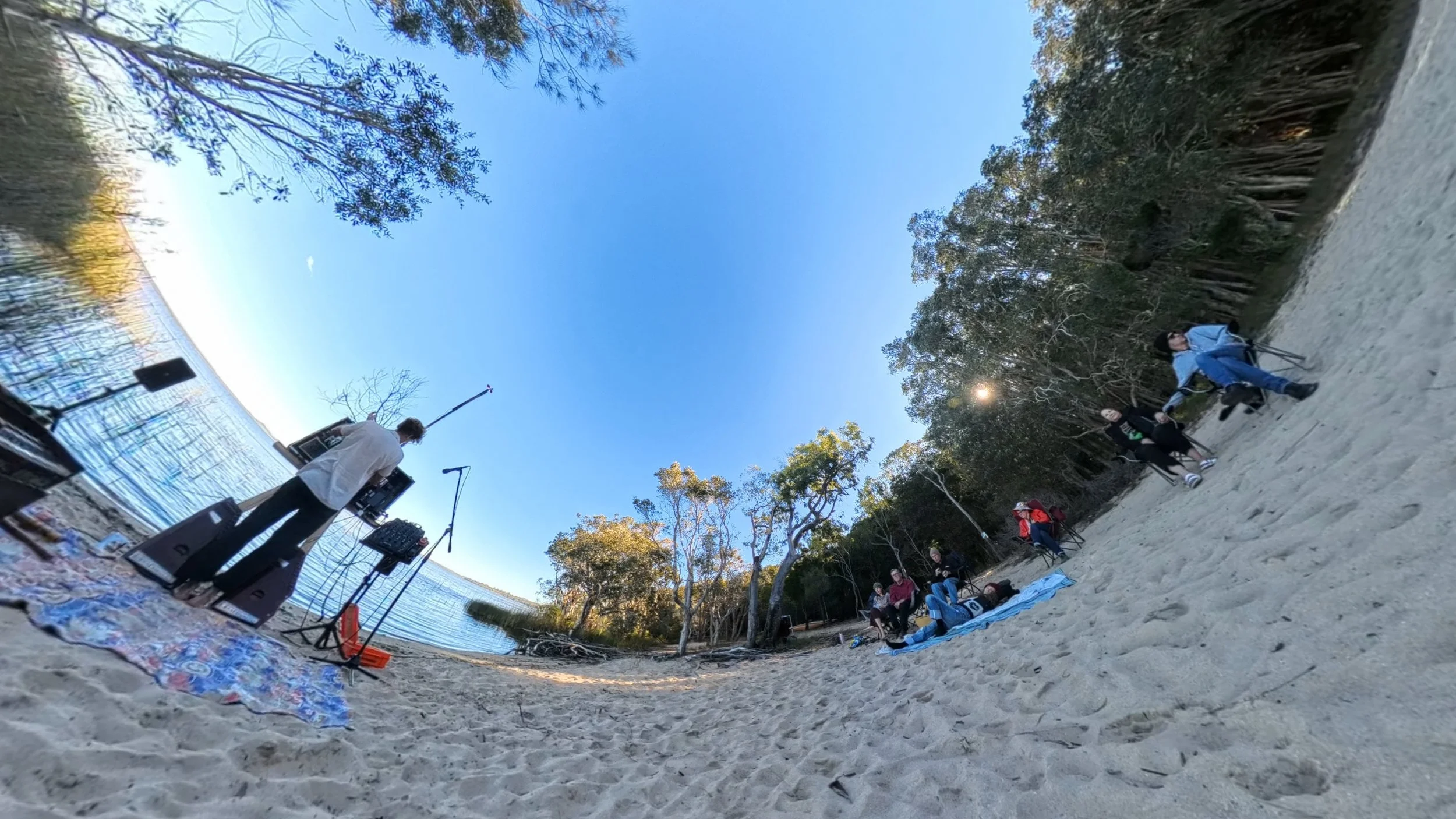Performance 4: Elanda Finale
C’est finis! On Sunday I performed the final ‘Hearing Now’ iteration at Floating Land. This was organized somewhat last minute - I reached out to Michael, the festival director, late last week expressing interest in performing a soft landing conclusion for the festival. What was originally intended to be my final performance - a collaboration with Francois Devan’s pilgrimage artwork - had been moved to Friday night, and would take place at the end of the pilgrimage walk out in Gympie. It didn’t feel quite right finishing the project that far outside Noosa, so I asked Michael if I could deliver a final work back at the original spot, the small beach cove at Elanda Point.
I am reticent to include the performance out at Gympie in the research of this project - it did not quite fit with the iterative progression of the works in Noosa, and I was unable to incorporate some of the techniques that I had been developing until now. This is mostly due to the differences in place - my work in Noosa was quite defined by Lake Cootharaba; the body of water as well as the surrounding ecology, in particular the paperbark trees. The location in Gympie was a paddock next to a brewery, where the pilgrims would camp. The paddock, as can be expected, was quite empty, bordered on one side by a row of large pine trees. There wasn’t much to suggest interesting environmental interaction; no water, no loose dirt, and no trees other than the pines. As I drove out to perform the set, I meditated on this fact, and decided I would use the absence as the environmental characteristic for collaboration. I decided to place the speakers as far away as I could, and to put myself further into the paddock than the campers, to produce sound through as much intermediary space as was possible. The effect of this was that the ambient environmental sound was even more on-par with the amplitude of my sound, and that my performance was more acutely embedded in the wide, open space. I did not perform for long - maybe 45 minutes as dusk fell into night. At first, I conversed with some of the pilgrims, and enjoyed a glass of wine, while curating some drones. The final twenty minutes had a captive audience - the group of pilgrims spread themselves and sat on log cross sections and gazed at the changing sky. I played undulating drones, a tonic and a lower fifth, interspersed with some echoing, percussive melodies. To punctuate the work, I also introduced a nocturnal field recording that I had gathered from Boreen Point during the original Floating Land: Escape Making residency. I introduced this layer vocally, speaking into my microphone, and explained how this recording might create a bit of a dialogue between place in Gympie and the lake where their walk had conceptually begun. Later, many members of the audience gave positive feedback regarding this element, mentioning that they appreciated imagining the two places conversing with one another. Some pilgrims also mentioned how the space and time to watch the sky was appreciated after a long day of walking, and that they had rarely given the sky such attention over such a duration. I appreciated that feedback. As this performance was quite short, and a little thrown together, I don’t feel like it has much to contribute to the project. Though, it does outline some of the challenges of site-responsive performance when working with ‘featureless’ places. As Robert Macfarlane writes, “Barrenness is a state of mind more than a state of place” - this idea helped push me to engage with the place despite it’s perceived plain-ness. I’m sure there could be more interesting ways of working with it, but in the end the use of distance does still appeal to me. Using emptiness as material - revealing emptiness - modulating sound through space (a la Thoreau) - there is something there. My speakers were a little too small to engage this fully however; I was on the edge of distortion for much of the set. I did not record video of this performance.
So, following that small side quest, I was excited to conclude the series properly back at Elanda. I arrived nice and early to another beautiful, placid afternoon at the lake, with clear skies and wavering shadows slowly crawling across the sand from tree-line to shore. Facing south-east, I once again gazed at the familiar curvature of the Noosa headlines, rolling into one another like wave breaking across the horizon. Setting up slowly, I chose to again contact-mic the complex root system in the southern corner of the cove. Roots wrestle and intermingle with one another in this patch, where two interwoven paperbarks meet the water’s edge. Reeds of thick, long grass reach up through gaps as well. I had used this root system in the second performance here, but I had not been completely content with how I performed them. That time, I was a little too rushed in my interactions, and approached the roots as sources of texture and impacts rather than something musical. This time, I instead found a comfortable place to sit, and experimented with finger drumming across the roots to my left and right, interweaving palm hits and slides in my impression tabla playing. This sounded much nicer - more subtle and musical - and I practiced performing alongside some percussive melodies in the synth. I ended up performing the roots twice in this way during the set, each time drumming on a couple of roots for a spell, hearing the melodies periodically die out (due to some amplitude modulation), moving to another set of roots, and finding another complementary rhythm. The fact that walking across the roots also created textural sounds led me to walk delicately - treading softly - defining my interaction as one of respect and exploration. I also punctuated these sections by dropping or throwing handfuls of sand onto or into the root network, which created some really interesting granular impacts. I think my performance of the tree-as-instrument reached a nice maturity in this iteration. The signal sounded good, with an effective tune and little distortion, and I think my playing included more musically rhythmic material that expanded the range of the work.
The first half of the performance went wonderfully smoothly. A small crowd slowly grew as I teased in a palette of drones and decorated it with spells of flute and branch-resonator interaction. Reflecting Cameron’s feedback, I made sure to speak to the audience at times throughout - openly appreciating the slowness of the lake on this particular afternoon, and highlighting that we could hear the paperbark when breaths of wind blew through. I also took an opportunity to not touch the synth, or any instruments, instead simply meditating while gazing at the lake as drones modulated around one another. My father later outlined this as a key point, one that was incredibly engaging due to his amazement that the synth can just ‘keep going’ without me directing it. I think I should take more opportunities to do this - the calm stasis of my body is a good sign to the audience, and it helped me to not introduce too much sonic action. As Julia said, the drones are really all it needs! It is really my overexposure to them that pushes me to add layers…
Again, I took a break about halfway through to allow the audience a moment to ‘come up for air’, and reminded them about the voicemail method. At the previous performance (at Boreen Pt) I had left this until about three quarters of the way through - this time I was bang on the one hour mark. The break worked well, I think people appreciated it, though the lack of reception at this spot may have prevented any successful voicemails. The one point of awkwardness came with how I reintroduced the performance. Upon recommencing, I invited people to interact with the roots, and then began performing in a new key - D mixolydian, roughly a minor key. I haven’t quite been able to introduce a minor mode in a way that has felt satisfying across any of the performance, except for perhaps the first one with Sachi and Julia. It just always ends up feeling a little incongruous with the space. I got it a bit better last time, playing the minor part on my smaller flute and really calling out into the reverb, but this time on the bigger flute did not really feel right. This kind of ‘unsure’ and melancholy musical atmosphere did not seem to benefit the exploration of the audience members on the roots. Plus, I tried to add a layer of flute, which seemed to make the explorers unsure of whether they should be making sound that might clash with my flute playing. So, in reflection, it is probably best to leave some wide open space for audiences to explore the tree within - especially when there aren’t any kids! Koa and Reef definitely did not mind if they clashed with me last week at Boreen Point. The one redeeming result of the confusion in the minor mode is that when I shifted to D Major, announced by some great big strums on the D zither, a real palpable sense of peace and calm overwhelmed the scene. Each time I have switched back to a major key, or ionian mode, time has really felt to have slowed down - the slow natural timescale of the place comes back into focus, and I’m sure I feel my heart rate drop. Perhaps this is an avenue for some musical modulation in response to the environment: Go minor / mixolydian / dorian when the wind is up and the water is choppy; come back to major / ionian when the wind dies and the lake goes glassy again.
Back in major tonality, I slowly moved between flute, melodies in the synth, and a little harmonium. At one point, Chelsea rolled up her pants to walk into the water, and I handed her the zither. She strode out to the roots, firstly tapping and stroking them, but then had the genius idea to put the zither on them and strum it! Although it distorted, it sounded fantastic. A big, overdriven, resonant chord, full-bodied through the response of the roots, crashed like invisible waves of the night into the soundscape. It really worked well. I added a drone on the harmonium and followed her queue. This is probably my favorite part of the performance. Leah said she thought it was rehearsed!
After this section, I took some time to let it simmer, then headed back to the roots for some particularly Carnatic inspired finger drumming, playing along to some echoing melodies made with 808s and some octave shifted granular delays. Adding some rolling, repetitive rhythms to this section felt really fitting - it felt like the onward progression of the day into evening - regular, momentous, unstoppable. One member of the audience later told me that it reminded him of the drumming he had heard in the military - interesting! This section was quite beautiful, and continues to be so in the recording. The one other moment of awkwardness followed - I was a little too quick in picking up the zither and walking to the rear of the audience. I immediately noticed that I hadn’t given the section enough time to resolve, to sink away, or for the environment to come back into focus. It is really important to relax in between sections, to take the time to listen, to reset and to consider. I do find myself falling into feelings of pressure, thinking I need to grab the next thing that will complement the drones, but really the most important thing I should do is create space and allow things to just sit again. I realized this after I had walked to the back of the audience, and tried to create some space there, but I could feel that people were wondering what it was that I was about to do. So, I moved through the audience, strumming the zither and waving it around each person’s head. I think that this brings sound into recognizable space, and back into a personal context. That and the zither sounds really cool spatialized around a listener’s head.
Finally, I returned to the synth and again, ever so slowly, turned down the drones, leaving a few minutes of ambient sound to bookend the piece. One thing that Leah pointed out later is how still the audience was during these final few minutes - it is really rare for people to be that patient and engrossed as a performance is ending, or after it has ended. I look forward to having a closer look at this in the 360 degree recording. Leah, and several others, also found themselves whispering when talking to me or each other after the set - isn’t that interesting? We all achieved such a reverence of the environment that we are subconsciously reluctant to interrupt it.
I got the best recording yet of this set as well - finally! I have formatted it into a 360 video with the ambisonic mics in the rear (the front two peaked) and my stereo recording from the desk in the front. A little early-reflection reverb helped to blend it, and it now sounds really full and delicate - a harmonious blend of the real and synthesized soundscapes. I think there is a digital work in this, and I intend to cut out the best sections to create a shorter work for VR or immersive environments. Perhaps to exhibit at the AFAE meetup? For now I will upload the set in its entirety.
Watching it back - almost each section could have gone for longer. The greatest lesson from this whole thing? Longer - Less - More space.


